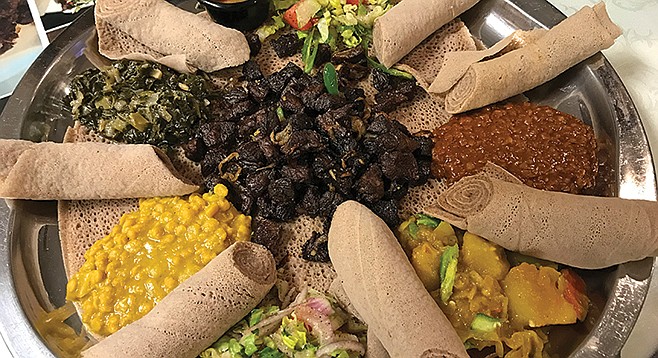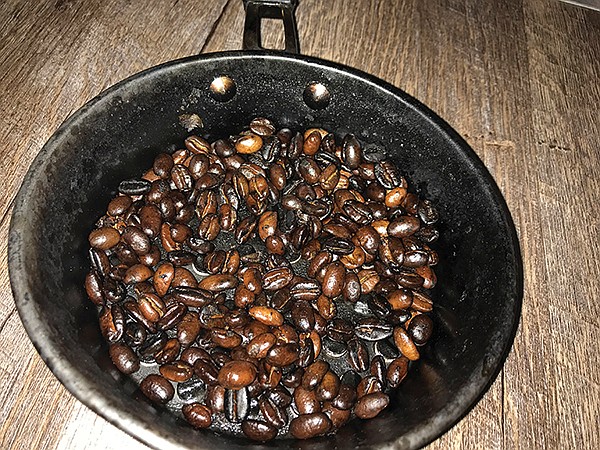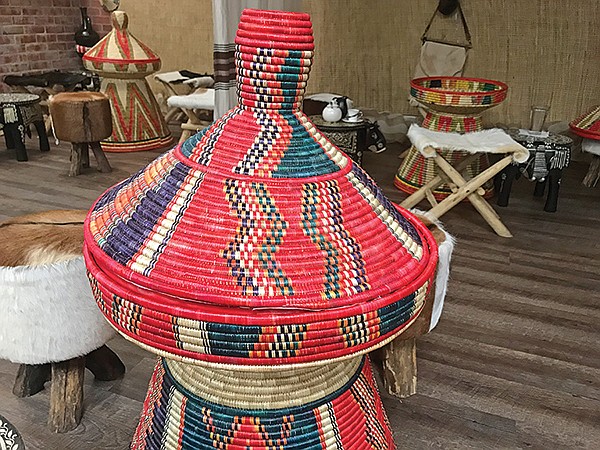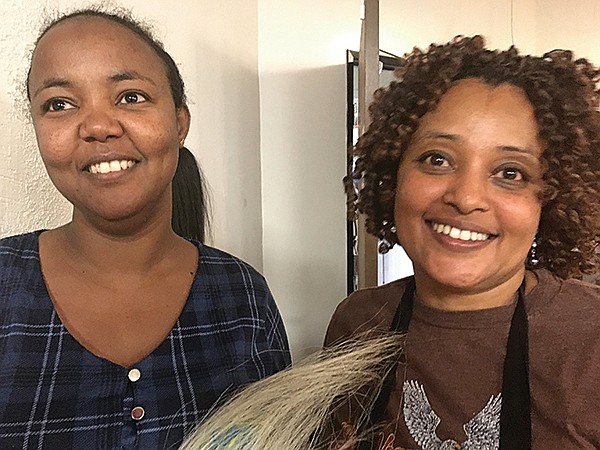 Facebook
Facebook
 X
X
 Instagram
Instagram
 TikTok
TikTok
 Youtube
Youtube

Cold night. I’m walking down El Cajon Boulevard, fully intending to cut north and head for Rosie O’Grady’s pub on Adams Avenue for a solid Irish stew. What’s making me hesitate is this Ethiopian place here. It has lots of people sitting among colorful round wicker tables with animal hide stools.
Hmm. Why not switch Irish stew to Ethiopian stew? I hurry into the warmth of this big room, half western and neon-lit, and half like a scene out of Ethiopia’s capital, Addis Ababa.
Customers inside look Ethiopian, with a smattering of Anglos.

“Welcome,” says this gal.
“Can I sit in the traditional part?” I ask.
“Yes, of course.”
Her name’s Music.
She leads me under a canopy. Oh man. This is so cool. I plop myself down on one of the barchumas, stools. They’re covered in brown and white goat hair. I start checking the menu.
I mean, I’ve had Ethiopian before, but all I can remember is the injera. That’s the slab of crumpet-looking fermented teff pancake that goes with every meal. There are no knives or forks in Ethiopian eating. You eat with your hand. Your right hand. You need injera to scoop up whatever you’re eating.

What I also remember is how Ethiopia has been Christian for maybe 200 years longer than most European nations. Also: how their injera is twice as good for you as the breads we normally eat.
Music crosses towards another table. She’s delivering a big round tray loaded with goodies. She names them to me. “In the middle is derek tibs, dry sautéed lamb chunks. Then we have salad, potato, carrots, red lentils, African collard greens, and yellow lentils,” she says. In between, rolls of injera are laid out like spokes of a wheel. Goes for $10.99. “Enough for two,” says Music.
Not bad. And the derek tibs smell garlicky-delicious. “And they have the berbere powder, like paprika but with other spices mixed in,” says Music.
Back to the menu: kitfo is a finely chopped beef with herbed butter and cheese ($10.99). Or kurt is spiced raw meat ($10.99). And they have another tibs dish called chekena tibs, beef, for $13.99. Yebeg (lamb) tibs is $12.99. In fact they have about two dozen varieties of meat stews or sautées, starting with sanbusa (triangles of pita bread stuffed with lentils or beef) for $1.99, to the kitfo (beef) sandwich for $6.99, to the main dishes, from $11 to $15.

“But many Americans come for our vegan dishes,” says Music. “Fosolia with carrot is the most popular. ‘Fosolia’ is string beans. They’re cooked with tomato, garlic, green pepper ($7.99).”
The dish that catches my eye is #19, dero wot, “chicken stew simmered in berbere ginger, garlic onion, special butter, served with hard-boiled egg and cottage cheese.” It says dero wot is a “most popular Ethiopian traditional dish.” Ethiopians usually reserve it for special days.

I go for that. The chef, Alemtsehay (her name means “World Sun,” “but call me Alem”), brings mine on its own gebeta — tray — places it under the woven lid of the mesob, unlids, and leaves it steaming up into my nostrils. It’s that berbere spice that delivers the defining flavor from the pile of stew covering a chicken leg and a large, stew-stained boiled egg. Cottage cheese, salad, and rolled chunks of injera radiate from it around the tray. I start ripping injera and squelching stew, chicken, and egg into my mouth. Hot? Yes, prickly, but not too intense. I cool things down with cottage cheese, salad and injera. But I swear, that berbere spice is addictive.
Two traditionally-dressed girls come and settle into the next “tent.” “We are Somali, not Ethiopian,” says one, Ayan. “You should try our food, too.”
Note to self: go eat Somali food next.
Meantime, next night, I haul my friend Annie back here, see what she thinks.
“Goodness,” she says, when we come in. This time the place is rich in incense smells. Music sits us down and brings a clay incense burner. We’re talking actual frankincense and myrrh.
This time we get a big tray of derek tibs, the dry sautéed lamb chunks, and chekena tibs (beef, not so dry as derek tibs) for Annie. Turns out you’ve really got to watch the awaze, a sauce mixed with Ethiopian mustard and chili powder. The mustard’s like horseradish mixed with wasabi, and it’s a fire-breathing show-stopper.
But the real show stopper is the coffee. Alem turns up with a frypan of green coffee beans. “These beans come from Ethiopia, where coffee was born,” she says. Then she returns to the kitchen, and soon we’re smelling the wicked aroma of beans roasting. She comes back, shows the blackened beans, tips them into a mortar, and starts grinding them with a stone pestle. She tips the bean grinds into a large long-necked black clay coffee pot full of boiling water.
That’s it. Oh man. Pungent. She pours black steaming coffee into two small cups, adds teaspoons of sugar, and hands them to us.
I swear. The most beautiful coffee I can remember. The pot has enough for eight pours, plus it’s strong enough for a refill. Costs $9.99. You can get a smaller pot for $3.49.
“Normally, Ethiopian people will gather round after the meal, and just talk and drink coffee for maybe two hours,” says Fekadu, the manager, who’s come over to check on us. “All the important decisions happen around this coffee pot.”
The smoke from the incense curls up. It feels like we’re in a caravanserai. “Carla would have loved this,” says Annie. She was her buddy.
I just nod and sip my coffee. Still miss that gal.


Cold night. I’m walking down El Cajon Boulevard, fully intending to cut north and head for Rosie O’Grady’s pub on Adams Avenue for a solid Irish stew. What’s making me hesitate is this Ethiopian place here. It has lots of people sitting among colorful round wicker tables with animal hide stools.
Hmm. Why not switch Irish stew to Ethiopian stew? I hurry into the warmth of this big room, half western and neon-lit, and half like a scene out of Ethiopia’s capital, Addis Ababa.
Customers inside look Ethiopian, with a smattering of Anglos.

“Welcome,” says this gal.
“Can I sit in the traditional part?” I ask.
“Yes, of course.”
Her name’s Music.
She leads me under a canopy. Oh man. This is so cool. I plop myself down on one of the barchumas, stools. They’re covered in brown and white goat hair. I start checking the menu.
I mean, I’ve had Ethiopian before, but all I can remember is the injera. That’s the slab of crumpet-looking fermented teff pancake that goes with every meal. There are no knives or forks in Ethiopian eating. You eat with your hand. Your right hand. You need injera to scoop up whatever you’re eating.

What I also remember is how Ethiopia has been Christian for maybe 200 years longer than most European nations. Also: how their injera is twice as good for you as the breads we normally eat.
Music crosses towards another table. She’s delivering a big round tray loaded with goodies. She names them to me. “In the middle is derek tibs, dry sautéed lamb chunks. Then we have salad, potato, carrots, red lentils, African collard greens, and yellow lentils,” she says. In between, rolls of injera are laid out like spokes of a wheel. Goes for $10.99. “Enough for two,” says Music.
Not bad. And the derek tibs smell garlicky-delicious. “And they have the berbere powder, like paprika but with other spices mixed in,” says Music.
Back to the menu: kitfo is a finely chopped beef with herbed butter and cheese ($10.99). Or kurt is spiced raw meat ($10.99). And they have another tibs dish called chekena tibs, beef, for $13.99. Yebeg (lamb) tibs is $12.99. In fact they have about two dozen varieties of meat stews or sautées, starting with sanbusa (triangles of pita bread stuffed with lentils or beef) for $1.99, to the kitfo (beef) sandwich for $6.99, to the main dishes, from $11 to $15.

“But many Americans come for our vegan dishes,” says Music. “Fosolia with carrot is the most popular. ‘Fosolia’ is string beans. They’re cooked with tomato, garlic, green pepper ($7.99).”
The dish that catches my eye is #19, dero wot, “chicken stew simmered in berbere ginger, garlic onion, special butter, served with hard-boiled egg and cottage cheese.” It says dero wot is a “most popular Ethiopian traditional dish.” Ethiopians usually reserve it for special days.

I go for that. The chef, Alemtsehay (her name means “World Sun,” “but call me Alem”), brings mine on its own gebeta — tray — places it under the woven lid of the mesob, unlids, and leaves it steaming up into my nostrils. It’s that berbere spice that delivers the defining flavor from the pile of stew covering a chicken leg and a large, stew-stained boiled egg. Cottage cheese, salad, and rolled chunks of injera radiate from it around the tray. I start ripping injera and squelching stew, chicken, and egg into my mouth. Hot? Yes, prickly, but not too intense. I cool things down with cottage cheese, salad and injera. But I swear, that berbere spice is addictive.
Two traditionally-dressed girls come and settle into the next “tent.” “We are Somali, not Ethiopian,” says one, Ayan. “You should try our food, too.”
Note to self: go eat Somali food next.
Meantime, next night, I haul my friend Annie back here, see what she thinks.
“Goodness,” she says, when we come in. This time the place is rich in incense smells. Music sits us down and brings a clay incense burner. We’re talking actual frankincense and myrrh.
This time we get a big tray of derek tibs, the dry sautéed lamb chunks, and chekena tibs (beef, not so dry as derek tibs) for Annie. Turns out you’ve really got to watch the awaze, a sauce mixed with Ethiopian mustard and chili powder. The mustard’s like horseradish mixed with wasabi, and it’s a fire-breathing show-stopper.
But the real show stopper is the coffee. Alem turns up with a frypan of green coffee beans. “These beans come from Ethiopia, where coffee was born,” she says. Then she returns to the kitchen, and soon we’re smelling the wicked aroma of beans roasting. She comes back, shows the blackened beans, tips them into a mortar, and starts grinding them with a stone pestle. She tips the bean grinds into a large long-necked black clay coffee pot full of boiling water.
That’s it. Oh man. Pungent. She pours black steaming coffee into two small cups, adds teaspoons of sugar, and hands them to us.
I swear. The most beautiful coffee I can remember. The pot has enough for eight pours, plus it’s strong enough for a refill. Costs $9.99. You can get a smaller pot for $3.49.
“Normally, Ethiopian people will gather round after the meal, and just talk and drink coffee for maybe two hours,” says Fekadu, the manager, who’s come over to check on us. “All the important decisions happen around this coffee pot.”
The smoke from the incense curls up. It feels like we’re in a caravanserai. “Carla would have loved this,” says Annie. She was her buddy.
I just nod and sip my coffee. Still miss that gal.